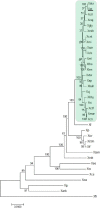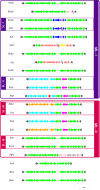Ecological and Evolutionary Insights into Xanthomonas citri Pathovar Diversity
- PMID: 28258140
- PMCID: PMC5394309
- DOI: 10.1128/AEM.02993-16
Ecological and Evolutionary Insights into Xanthomonas citri Pathovar Diversity
Abstract
Citrus canker, caused by Xanthomonas citri pv. citri, is a serious disease of citrus plants worldwide. Earlier phylogenetic studies using housekeeping genes revealed that X. citri pv. citri is related to many other pathovars, which can be collectively referred as Xanthomonas citri pathovars (XCPs). From the present study, we report the genome sequences of 18 XCPs and compared them with four XCPs available in the public domain. In a tree based on phylogenomic marker genes, all the XCPs form a monophyletic cluster, suggesting their origin from a common ancestor. Phylogenomic analysis using the type strain further established that all the XCPs belong to one species. Clonal analysis of the core genome revealed the presence of two major lineages within this monophyletic cluster consisting of some clonal variants. Incidentally, the majority of these XCPs were first noticed in India, corroborating their clonal relationship and their common origin. Comparative analysis revealed an open pan-genome and the role of interstrain genomic flux of these XCPs since their diversification from a common ancestor. Even though there are wide variations in type III gene effectomes, we identified three core effectors which can be valuable in resistance-breeding programs. Overall, genomic examination of ecological relatives allowed us to dissect the tremendous genomic potential of X. citri species to rapidly evolve into specialized strains infecting diverse crop plants.IMPORTANCE Host specialization is one of the characteristic features of highly evolved pathogens such as the Xanthomonas group of phytopathogenic bacteria. Since the hosts involve staple crops and economically important fruits such as citrus, detailed understanding of the diversity and evolution of such strains infecting diverse plants is important for quarantine purposes. In the present study, we carried out genomic investigation of members of a phylogenetically and ecologically defined group of Xanthomonas strains pathogenic to diverse plants, including citrus. This group includes the oldest Xanthomonas pathovars and also recently emerged pathovars in a particular country where they are endemic. Our high-throughput genomic study has provided novel insights into the evolution of a unique lineage consisting of serious pathogens and their ecological relatives, suggesting the nature, scope, and pattern of rapid and recent diversification. Further, from the level of species to that of clonal variants, the study revealed interesting genomic patterns in diversification of a Xanthomonas lineage and perhaps will inspire careful study of the host range of the included pathovars.
Keywords: India; Xanthomonas; ecology; evolution; hypervariation; pathovar.
Copyright © 2017 American Society for Microbiology.
Figures






Similar articles
-
Phylogenomic Insights into Diversity and Evolution of Nonpathogenic Xanthomonas Strains Associated with Citrus.mSphere. 2020 Apr 15;5(2):e00087-20. doi: 10.1128/mSphere.00087-20. mSphere. 2020. PMID: 32295869 Free PMC article.
-
Core-Genome Multilocus Sequence Typing for Epidemiological and Evolutionary Analyses of Phytopathogenic Xanthomonas citri.Appl Environ Microbiol. 2023 May 31;89(5):e0210122. doi: 10.1128/aem.02101-22. Epub 2023 Apr 17. Appl Environ Microbiol. 2023. PMID: 37067413 Free PMC article.
-
Amplified fragment length polymorphism and multilocus sequence analysis-based genotypic relatedness among pathogenic variants of Xanthomonas citri pv. citri and Xanthomonas campestris pv. bilvae.Int J Syst Evol Microbiol. 2010 Mar;60(Pt 3):515-525. doi: 10.1099/ijs.0.009514-0. Epub 2009 Aug 4. Int J Syst Evol Microbiol. 2010. PMID: 19654364
-
Genomic insights into the evolutionary origin of Xanthomonas axonopodis pv. citri and its ecological relatives.Appl Environ Microbiol. 2014 Oct;80(20):6266-79. doi: 10.1128/AEM.01654-14. Epub 2014 Aug 1. Appl Environ Microbiol. 2014. PMID: 25085494 Free PMC article.
-
Xanthomonas as a Model System for Studying Pathogen Emergence and Evolution.Phytopathology. 2024 Jul;114(7):1433-1446. doi: 10.1094/PHYTO-03-24-0084-RVW. Epub 2024 Jul 5. Phytopathology. 2024. PMID: 38648116 Review.
Cited by
-
Complete Genome Sequence Reveals Evolutionary and Comparative Genomic Features of Xanthomonas albilineans Causing Sugarcane Leaf Scald.Microorganisms. 2020 Jan 28;8(2):182. doi: 10.3390/microorganisms8020182. Microorganisms. 2020. PMID: 32012870 Free PMC article.
-
Phylogenomic Insights into Diversity and Evolution of Nonpathogenic Xanthomonas Strains Associated with Citrus.mSphere. 2020 Apr 15;5(2):e00087-20. doi: 10.1128/mSphere.00087-20. mSphere. 2020. PMID: 32295869 Free PMC article.
-
A highly specific tool for identification of Xanthomonas vasicola pv. musacearum based on five Xvm-specific coding sequences.Heliyon. 2018 Dec 27;4(12):e01080. doi: 10.1016/j.heliyon.2018.e01080. eCollection 2018 Dec. Heliyon. 2018. PMID: 30603713 Free PMC article.
-
Deep Population Genomics Reveals Systematic and Parallel Evolution at a Lipopolysaccharide Biosynthetic Locus in Xanthomonas Pathogens That Infect Rice and Sugarcane.Appl Environ Microbiol. 2022 Aug 23;88(16):e0055022. doi: 10.1128/aem.00550-22. Epub 2022 Aug 2. Appl Environ Microbiol. 2022. PMID: 35916503 Free PMC article.
-
Genomic sequence analysis reveals diversity of Australian Xanthomonas species associated with bacterial leaf spot of tomato, capsicum and chilli.BMC Genomics. 2019 Apr 23;20(1):310. doi: 10.1186/s12864-019-5600-x. BMC Genomics. 2019. PMID: 31014247 Free PMC article.
References
-
- Leyns F, De Cleene M, Swings J-G, De Ley J. 1984. The host range of the genus Xanthomonas. Botanical Rev 50:308–356. doi:10.1007/BF02862635. - DOI
-
- Hayward A. 1993. The hosts of Xanthomonas, p 1–119. In Xanthomonas. Springer, New York, NY.
-
- Dye D, Bradbury J, Goto M, Hayward A, Lelliott R, Schroth M. 1980. International standards for naming pathovars of phytopathogenic bacteria and a list of pathovar names and pathotype strains. Rev Plant Pathol 59:153–168.
-
- Schaad NW, Postnikova E, Lacy GH, Sechler A, Agarkova I, Stromberg PE, Stromberg VK, Vidaver AK. 2005. Reclassification of Xanthomonas campestris pv. citri (ex Hasse 1915) Dye 1978 forms A, B/C/D, and E as X. smithii subsp. citri (ex Hasse) sp. nov. nom. rev. comb. nov., X. fuscans subsp. aurantifolii (ex Gabriel 1989) sp. nov. nom. rev. comb. nov., and X. alfalfae subsp. citrumelo (ex Riker and Jones) Gabriel et al., 1989 sp. nov. nom. rev. comb. nov.; X. campestris pv. malvacearum (ex Smith 1901) Dye 1978 as X. smithii subsp. smithii nov. comb. nov. nom. nov.; X. campestris pv. alfalfae (ex Riker and and Jones, 1935) Dye 1978 as X. alfalfae subsp. alfalfae (ex Riker et al., 1935) sp. nov. nom. rev.; and “var. fuscans” of X. campestris pv. phaseoli (ex Smith, 1987) Dye 1978 as X. fuscans subsp. fuscans sp. nov. Syst Appl Microbiol 28:494–518. doi:10.1016/j.syapm.2005.03.017. - DOI - PubMed
Publication types
MeSH terms
Substances
LinkOut - more resources
Full Text Sources
Other Literature Sources
Molecular Biology Databases

